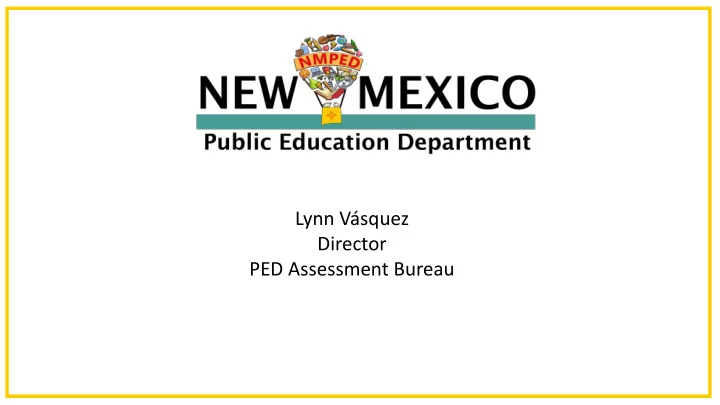

Lynn Vásquez Director PED Assessment Bureau
Student Success Task Force 2
Creating a Balanced Assessment System A balanced assessment system recognizes that classroom formative assessments and other local practices co- exist with state summative assessments, as multiple measures , to provide a full picture of a student’s performance. Meaningful assessment practices at the local level can range in variety from the simple (e.g., exit ticket) to more complex (e.g., performance-based tasks). The goal of a balanced assessment system is to provide students, parents, educators, policy makers, and communities with a variety of useful information about academic achievement and progress. 3
Two Phases of Task Force Recommendations Phase I Phase II (Short-term) (Long-term vision) Determine requirements for a statewide A balanced assessment system (e.g., interim summative assessment for Spring 2020 and formative supports) administration with certain constraints : •Timeline of implementation Assessment literacy support (e.g., how to •Necessary supports and accommodations interpret data from different sources for for English learners and students with different audiences; common vocabulary) disabilities •Mathematics and English language arts for grades 3-9 and high school Additional measures of student success •Complying with the Every Student Succeeds (e.g., K–2, Spanish language arts, Act, as required federally performance-based assessments) 4
Timeline Assessment Events January 2019 Governor’s Executive Order to Transition from PARCC March 2019 Stakeholder engagement meetings April – June 2019 Student Success Task Force convened June-October 2019 Procurement for new assessments to replace PARCC: Phase I October 2019 Final Student Success Task Force Report November 2019 New State Summative Assessment Announced January 2020 Launch of Phase II 5
Guiding Principles for New Mexico’s Assessment System . Equity Accessibility New Mexico’s Assessment System Relevance Rigor 6
Gr Grad aduatio tion Requir irements ts Demonstration New Mexico Coursework of Competency Diploma of Requirements Requirements Excellence New Mexico Statute 22-13-1.1 New Mexico Administrative Code 6.19.7 and 6.29.1.9
• A standardized measure in five content areas: • Math Demonstration • Reading of Competency • Writing Requirements • Science • Social studies • Changing • Assessment Bureau
Cohort Cohort Cohort Cohort 2020 2021 2022 2023 Entered Entered Entered Entered grade 9 in grade 9 in grade 9 in grade 9 in 2016-17 2017-18 2018-19 2019-20 school year school year school year school year 6.19.7 6.19.7 6.19.7 6.19.7 NMAC NMAC NMAC NMAC 2009 2009 2018 2018 applies applies applies applies 9
https://webnew.ped.state.nm.us/bureaus/ college-career-readiness/graduation/
Me Menu of Options • ESSA-required assessments • Transition Assessment, PARCC, SBA (Cohorts 2020 and 2021) • SAT (Cohort 2021 and beyond) • NM-ASR (Cohort 2022 and beyond) • Other state assessments • EoCs (Cohorts 2020, 2021, 2022) • Exit Exams (Cohort 2023 and beyond) • Nationally recognized exams (ACT, ACCUPLACER, ASVAB, AP, IB, etc.) • Local Demonstration (Cohorts 2020 and 2021) • Competency-based options (Cohorts 2022 and beyond) • Performance-based options (Cohorts 2022 and beyond)
Ou Our Ultimate Goal: 1. Develop a set of quality criteria that all LEAs must use to establish their local demonstration of competency. Culturally responsive and relevant • Honors local wisdom • Santa Fe’s • Fosters student agency Innovation Deming’s Rigorus • Innovation • Etc South Valley 2. Development of a statewide peer review panel that would Academy “approve” each LEAs demonstration of competency as having met Innovation the standards of quality criteria. 3. Implement/allow local demonstration of competency practices that have met quality criteria requirements starting with cohort Informs the Creation of 2024 as a menu option. Quality Criteria 4. Scale best practices of innovation statewide. 5. Provide students with a more meaningful and rigorous option for graduation.
Recommend
More recommend